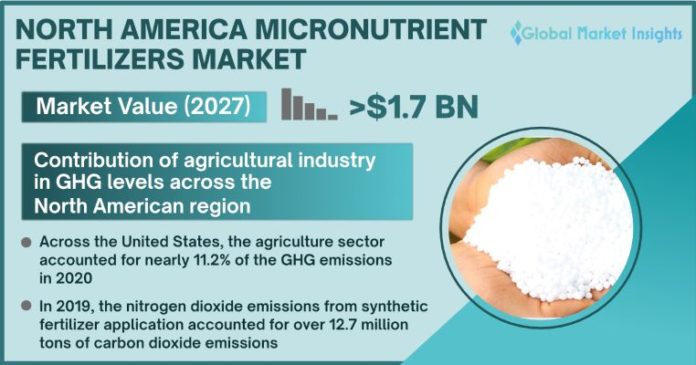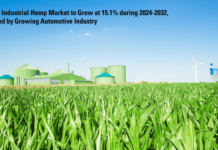An estimate by Global Market Insights Inc. suggests that North America micronutrient fertilizers market value could exceed USD 1.7 billion by 2027, attributed to the benefits these compounds have to offer to the regional farmers. Fertilizers with specific micronutrients can promote essential plant growth, converting into nutrient-rich enzymes for humans and animals.
The micronutrient fertilizers industry in North America has witnessed considerable growth in recent years. The arable land available in the region is currently under threat, majorly due to the growing population, soil degradation, and increasing frequency of natural calamities that can erode the soil away. According to the U.S. Census Bureau, the US population is forecasted to grow by 79 million by 2060, surpassing the 400-million mark in 2058.
Scientists have recently warned that 24 billion tons of fertile land is being lost almost annually, largely due to the unsustainable agricultural practices. Speculations indicate that if this trend continues, 95% of the Earth’s land areas could become degraded by 2050. This pressing challenge has compelled global agriculturists and farmers to shift to the use of sustainable fertilizer solutions to ensure proper crop yield and productive land.
With the population of North America increasing and the agricultural land available to farmers depleting, soil quality is of utmost importance. In this regard, micronutrient fertilizers have emerged as a feasible solution among agriculturists and farmers to enhance the crop yield.
The trend is expected to present new opportunities for micronutrient fertilizer suppliers across various regions, particularly the North America. The region is suited to cultivate diverse crops owing to varied climatic conditions.
Across the United States, the use of micronutrient fertilizers is strongly influenced by the value of the crop being cultivated. Also, the adoption of precision farming, growing use of genetically modified crops, intensity of production, and changes in crop choice are affecting the use the compounds.
Tackling manganese deficiency in plants: Analyzing the role of micronutrient in crop quality and growth
Manganese deficiency is a common occurrence in crops across areas such as the state of North Carolina in the US. Symptoms have been observed on small grains, cotton, corn, tobacco, and several other vegetable crops, leaving a yellow stain on the leaves. As a result, the use of manganese in fertilizers has gradually surged. Although used in small amounts by plant, manganese is of capital significance for healthy plant growth and plays an important part in the photosynthesis process.
It would be credible to note that the manganese rich fertilizers captured a share of over USD 30 million during 2020 in North America fertilizers industry. The segment was further expected to grow at a rate of more than 8% over up to 2027.
Introduction to ‘green’ micronutrient fertilizers could be the future of North America agriculture industry
Consider the given statistics for the contribution of agricultural industry in GHG levels across the North American region:
- Across the United States, the agriculture sector accounted for nearly 11.2% of the GHG emissions in 2020.
- In 2019, the nitrogen dioxide emissions from synthetic fertilizer application accounted for over 12.7 million tons of carbon dioxide emissions.
The alarming concerns raised by increasing use of synthetic fertilizers and their daunting impact on the environment have urged companies to ideate and develop bio-based micronutrient fertilizers that pose no or minimal risks to the ecology. A consortium of Lucent BioSciences, Aberhart Ag Solutions, AGT Food and Ingredients, and NuWave Research, for example, has collaborated on a USD 19 million project by Protein Industries Canada.
The consortium will work to commercialize a sustainable micronutrient fertilizer made from pea, lentil, and other plant-based hulls. This project would help Canadian farmers improve their sustainability and minimize carbon emissions via the marketing of new micronutrient fertilizers. With sustainable agricultural practices being at peak across the Canadian subcontinent, Canada micronutrient fertilizers market value is predicted to be over USD 270 million by 2027.
The thriving North American agriculture industry has opened new avenues for micronutrient fertilizer manufacturers. The US agriculture industry, in 2020, contributed more than USD 1 trillion to the country’s GDP. On the other hand, as per the US Department of Agriculture, Canadians spend 21% more on fruits & vegetables as compared to US consumers during 2021, indicating the substantial farming potential in the country. It should also be noted that the US exports a considerable about of food and agriculture products to Canada, representing the continuous demand for crop production and fertilizer consumption across North America.
With the agriculture sector being one of the leading employment segments in the region, the demand for micronutrient-rich fertilizers in the country would surge profoundly over the coming years. Not to mention, in efforts to maintain the continuous supply of food to the robust packaged food and food service sectors, farmers across North America are leaving no stone unturned to improve the soil quality & produce better yields. Fertigation and foliar applications can be expected to hold a significant share of micronutrient fertilizer consumption over the coming decades.









